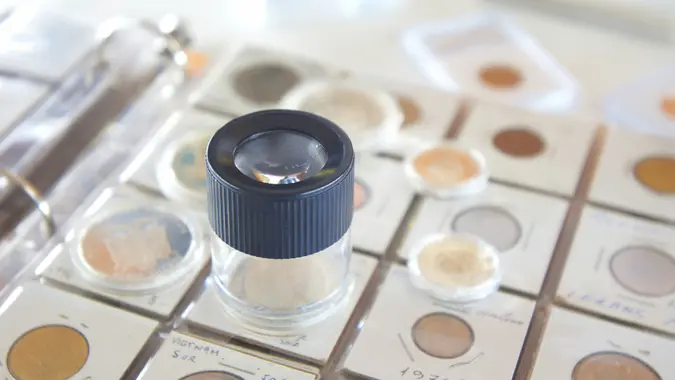Ramit Sethi: 6 Steps To Become a Millionaire by 40

Commitment to Our Readers
GOBankingRates' editorial team is committed to bringing you unbiased reviews and information. We use data-driven methodologies to evaluate financial products and services - our reviews and ratings are not influenced by advertisers. You can read more about our editorial guidelines and our products and services review methodology.

20 Years
Helping You Live Richer

Reviewed
by Experts

Trusted by
Millions of Readers
While being a millionaire by 40 is rare, it’s still possible if you can cut big expenses and regularly invest enough income based on your current age.
Financial guru and author Ramit Sethi reached this goal, and now focuses on helping others learn to build wealth. In a recent YouTube video, he outlined six steps that can help you become a millionaire by 40, even if you’re starting from zero.
Work Backwards From 40
Sethi said you first need to understand your definition of $1 million, such as whether that’s your ideal bank balance or home value, and examine your current standing in relation to your goal.
You can then count how many years you have until you reach age 40 and figure out a target monthly contribution amount using an investment calculator. For example, Sethi said you’d need to invest $1,639 per month if you’re 18 versus $5,813 if you’re 30 — that assumes you start with $0 and get a 7% return.
This shows that starting earlier makes becoming a millionaire easier since you can make smaller contributions. But don’t feel demotivated by such big numbers at any age.
Sethi explained, “We should remember that when you are younger, you make less money, and most people’s income increases over time.”
Commit to Investing 15% or More Now
Aggressive contributions from your income are key if you’re catching up when older, and you should remember that regularly investing income helps you maximize compound interest over a long time.
Sethi recommended a 15% minimum investment goal for everyone with the following guidelines:
- Contribute 5% of your earnings to your employer’s 401(k) and take advantage of any employer match, which can add up to many thousands of free dollars over time.
- Put 7% of your earnings in a Roth IRA (up to $7,000 in 2025 for those under 50).
- Go back and contribute as much as possible above your 401(k) employer match (up to $23,500 in 2025 for those under 50).
From there, Sethi suggested contributing at least 1% more of your income annually.
Increase Your Income
Sethi discussed how making more money is crucial to becoming a millionaire by age 40 since the increase can go toward investments. He first suggested negotiating a higher salary after researching market rates for your skills. He gave an example of someone who earned $100,000, got a $10,000 raise and followed his suggested investment plan while earning a 7% return.
Sethi explained, “If you took the entire amount of your raise every year, that full $10,000, and you invested it in your 401(k), you’d hit your million-dollar goal in only 16 years.”
He also discussed other money-making options, like having a side business or finding a higher-paying full-time job in a different company or industry.
Cut Housing and Vehicle Expenses
Sethi discussed how large housing and vehicle expenses can make it harder to invest.
First, he advised not spending more than 28% of your before-tax pay on total housing costs. Given that the Mortgage Bankers Association reported a $2,205 national median mortgage payment in February 2025, this limit can be challenging even for higher earners. Sethi gave money-saving tips like avoiding unnecessary upgrades, having a roommate and downsizing.
Next, he discussed how new and used vehicles often come with high monthly payments that make it hard to invest. Additionally, they can have high hidden costs. Sethi said, “When I used to have a $350 car payment for a V6 Honda Accord (four-door, my friends), the total monthly expense for me was over $1,000.”
Some cost-cutting tips include buying used, considering public transport and keeping your car rather than upgrading. Sethi also recommended that your car payment and other total fixed living costs not exceed 50% to 60% of your income.
Consider Renting and Investing the Savings
Sethi suggested reconsidering whether homeownership fits in with your plan to become a young millionaire. Renting is often cheaper in many cities, and homes have hidden costs that add up. He said, “In this very apartment that I’m sitting in right now, if I were to buy this apartment, it would cost me more than 2.5 times more than what I’m paying for rent.”
Even if running the numbers shows that renting saves you $500 per month for 15 years, you’d have over $150,000 based on a 7% investment return.
Besides comparing costs, Sethi advised looking at a mortgage amortization table to see how a larger portion of your mortgage payments goes toward interest during the first 20 years.
Ask Yourself Why
Sethi’s last recommendation was to ask what the reason is behind your goal to become a millionaire by age 40. You need to know what you want from it to make the sacrifice worth it, and you don’t want to be left disillusioned when you do reach the goal. Ultimately, he said, you need to decide what a rich life looks like to you.
More From GOBankingRates
Sources:
- YouTube, “If I Wanted to Become a Millionaire in 2025, I’d Do This.”
- Mortgage Bankers Association, “MBA: Mortgage Application Payments Remain Flat in February.”
 Written by
Written by  Edited by
Edited by 

























